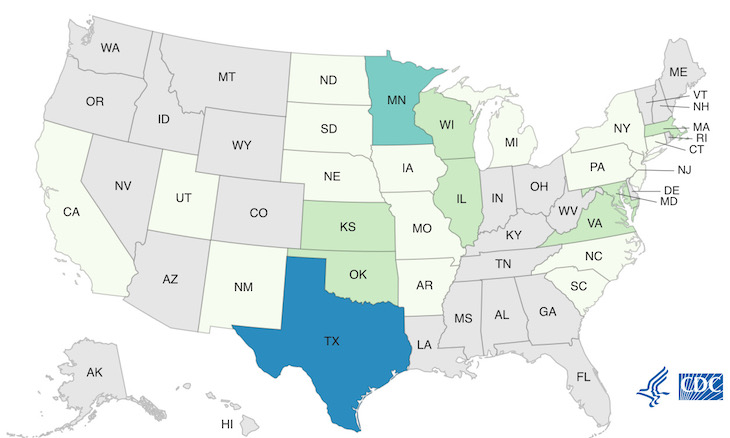A Salmonella Oranienburg outbreak with an unknown food source that has sickened 127 people in 25 states has been announced by the Centers for Disease Control and Prevention (CDC). While a specific food has not been identified, this outbreak is growing rapidly, according to the government. The outbreak was first announced on FDA’s CORE Outbreak Investigation Table on September 15, 2021.

The case count by state is: Arkansas (2), California (3), Connecticut (3), Illinois (5), Iowa (1), Kansas (5), Maryland (4), Massachusetts (7), Michigan (2), Minnesota (13), Missouri (2), Nebraska (2), New Jersey (2), New Mexico (3), New York (1), North Carolina (1), North Dakota (1), Oklahoma (7), Pennsylvania (2), South Carolina (1), South Dakota (1), Texas (45), Utah (1), Virginia (9), and Wisconsin (4). The patient age range is from less than 1 year to 82 years. Of 49 people who gave information about their illness to officials, 18 have been hospitalized, for a hospitalization rate of 37%, which is almost twice the percentage for a typical Salmonella outbreak.
On September 2, 2021 the CDC identified an outbreak of 20 Salmonella Oranienburg infections. As of September 15, 2021, just 13 days later, 127 people infected with the outbreak strain are included in this outbreak. The CDC states that this outbreak could be much larger than is currently known, and the outbreak may not be limited to these states.
Public health officials are interviewing people about the foods they ate the week before they got sick. While a specific food has not been identified, several subclusters at various restaurants in multiple states have been identified.
Those subclusters are groups of people who are not related and who do not know each other who ate at the same restaurant and got sick. These subclusters can sometimes help identify a food that could be the source of this outbreak. The FDA is analyzing records collected from restaurants where ill persons ate to try to identify a common distributor or supplier.
The PulseNet system is being used to identify members of this outbreak. Whole genome sequencing (WGS) used on isolates taken from patients shows that the bacteria that made these people sick are closely related genetically. That means that patients likely got sick from eating the same food.

If you or a loved one has been diagnosed with food poisoning, you can contact lawyer Fred Pritzker for help by calling 1-888-377-8900 or 612-338-0202.
Noted food safety attorney Fred Pritzker, who has represented many clients in Salmonella lawsuits against restaurants, grocery store chains, and food manufacturers, said, “This outbreak has grown very rapidly, and more people are likely sick. We hope that the CDC and state investigators can solve the outbreak so more people don’t get seriously ill. No one should be hospitalized just because they ate at a restaurant.”
Salmonella restaurant outbreaks in the past have been associated with poor food handling practices, undercooked eggs, and BBQ. Some of these outbreaks are never linked to a food source.
Symptoms of a Salmonella food poisoning infection include a fever, nausea, vomiting, stomach cramps, abdominal cramps and pain, and diarrhea that may be bloody. People usually start getting sick six hours to six days after infection. And while most people do recover without medical attention, anyone with this infection can develop complications such as endocarditis, high blood pressure, reactive arthritis, and irritable bowel syndrome.
If you have been ill with these symptoms, even if you live in a state not included in the outbreak total, see your doctor and ask for a Salmonella test. You may be part of this multistate Salmonella Oranienburg outbreak.

If you or a loved one have been sickened with a Salmonella infection, please contact our experienced attorneys for help at 1-888-377-8900 or 612-338-0202.




